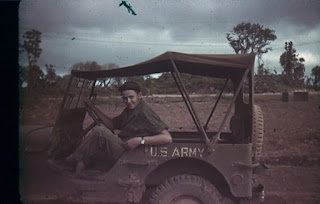Whoever heard of a tropical island paradise called Guam, one of the Marianas Island group? It was a beautiful place of palm trees, reefs and primitive native villages. It was taken by the US from Spain in 1898.
In December 1941, the island was captured by the Japanese at the beginning of World War II. This disrupted the plans and lives of many young Americans. Verlin left the university and joined the army where he was trained in repairing teletype machines. He was not sent directly to the war and found out later he and others with him were waiting for top secret clearances and were to be trained as code machine repairmen. By the time he finished all his training, the war was over in Europe. Eventually he was sent to San Francisco by train, then Hawaii for four days, then to Guam by plane.
He said, "We left Hamilton Field about 10 PM on the night of September 2, 1945, which was the day the Japanese war was officially ended. It was my first plane ride in a 'big' plane called a C47. It was a new plane going to pick up wounded so it had no seats. When it became light the next morning one of the fellows became concerned that one of the wings seemed to be flapping. We assured him that it was normal (of course we didn't know any more than he did). We landed at Hickam Field without difficulty. The next day we rode by the airfield and saw that they had removed that particular wing from the plane. We decided we had been very fortunate. From Hawaii we flew to Johnson Island then to Kwajalein and finally to Guam."
"Since the war was over we never did do any code machine work. We did transfer a large amount of equipment, which had been dropped in a field during the battles to retake Guam, to a warehouse."
Verlin on Guam
One thing Guam was famous for was having fields for the wonderful plane known as the B-29. Taking Guam back and basing the B-29s in that area was instrumental in helping US forces get close enough to defeat the Japanese and end the war.
Many of the planes had extensive 'nose art'.
Early in 1946, Verlin left Guam on a transport ship, the Olmstead, and transferred to Saipan to being the process of returning to civilian life. The camp on Saipan was on the opposite side of the island from the port. It took about 4 hours to go through the required processing. "Then we waited and waited. There were frequent rumors of ships arriving to get us, etc. Finally after about four days, we loaded back into trucks and recrossed the island to find the Olmstead waiting for us. It was a Kaiser built ship and not really luxury. There were 2500 men on board. We slept in cargo holds on canvas stretched on metal frames. As I remember, each bunk was about 24 inches wide and perhaps 6 feet long with about 15-18 inches to the bunk above. There were big garbage cans for those who became seasick. Not surprisingly, we spent as much time as possible on deck."
After traveling by troop ship for 2 weeks, they landed at Oakland, California where they were put on a troop train where they rode in a box car with bunks similar to those on the ship.
As a matter of interest, when Verlin first entered the army, he received $21 a month plus board, room and clothing. Then congress raised the pay for a private to $50 a month. When he became a private first class, he got a raise to $55 per month. Eventually he became a T/5 and got $66 a month for the rest of his time in the army.



































4 comments:
The "Ten Knights in a Bar Room" aircraft is my late father-in-laws aircraft. I would like to know more about where this photo came from if anyone knows more.
The picture was in my father’s photo album from when he was on Guam. I assumed he took the picture but I really cannot verify that.
My dad Willian (Billy) Brooks flew as a machine gunner on "the ten knights". I have pictures of the plane and him while on Guam.
I wish I had more.
My grandfather George Marter was the copilot of the 20th Century Fox aircraft. He was a billboard painter before the war and was the one that painted the nose art. My family still has the original draft he did on a piece of paper somewhere.
I have several pictures of the plane in my house and a picture of him on scaffolding painting the nose art.
Post a Comment